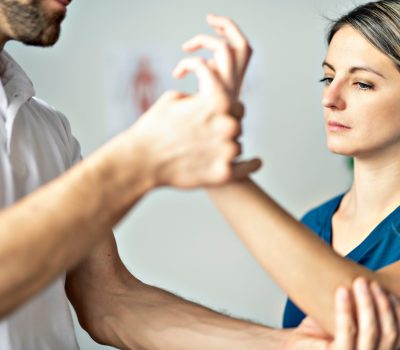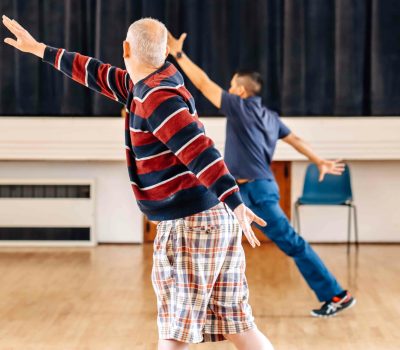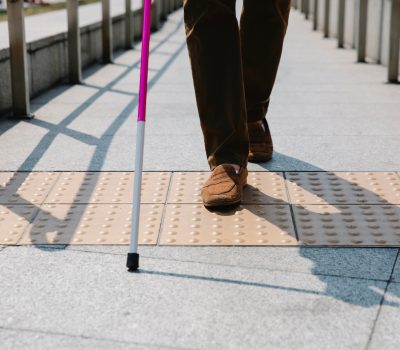Following a stroke or other brain injury, if you have ongoing weakness on one side (known as hemiplegia) your affected shoulder can sometimes drop a little and be painful. This is known as a shoulder subluxation.
If you dislocate your shoulder, the head of the upper arm bone is pulled completely out of it’s socket and needs medical attention to relocate it. When you have a shoulder subluxation, it only comes out part way. Shoulder subluxation after a stroke is quite common and is not the same as dislocation.
What causes a subluxation?
Your shoulder joint is a ball and socket joint that is made up of the ball of your upper arm bone (called the humerus) which fits into a cup-like socket (called the glenoid cavity). The shoulder joint is very unstable which is why you can move your arm in so many directions. Due to its instability, the joint is supported and held into place by lots of muscles and ligaments. If these muscles become weak or flaccid after a stroke or brain injury, the humeral head cannot be anchored within the glenoid cavity, so the upper arm bone can drop slightly. In a subluxation, the head of the arm bone can shift forwards, backwards or downward, or a combination of these.
If the muscles cannot anchor the humerus into the shoulder joint, the pure weight of the arm can be enough to cause a subluxation. Often poor handling and poor positioning following a stroke increases the risk of subluxation and it is important to ensure that you and anyone looking after you is aware of this and ensure your affected arm is well supported at all times – when sitting, standing, transferring and even in lying. Lack of support, even when in a horizontal position can cause further pain and worsening of a subluxation.
How will I be assessed for shoulder subluxation?
A physiotherapist or doctor would be able to determine if the shoulder joint is subluxed. They will ask you to undress and observe your body position. They would then feel your shoulder joint and compare it to the other side. If there is a subluxation there will be a palpable gap in between which feels different to your non-affected side.
What can I do about shoulder subluxation?
If you have a confirmed shoulder subluxation there are lots of ways to manage and potentially improve it:
Positioning: If you have a subluxation or a weak arm after a stroke, positioning is vitally important and you must ensure your arm is well supported at all times in lying, sitting and standing. Gravity will always act as force and pull further on your arm increasing pain and potentially worsening the subluxation. Positioning is particularly important if you have reduced sensation or awareness of your arm as you may not know where it is. It is recommended to place your arm on pillows when sitting or lying to support it and make sure it is always in view so you can make sure it is in a good position.
Pain relief: Pain is quite common if you have a subluxation, although it is not always present. If you have a painful shoulder, a doctor can explore medication with you to reduce your pain. This will help to position and move your arm more without it hurting.
Careful handling: If you require care support to help you move around, it is vital that they do not pull on your arm, as this can lead to worsening of pain and increased the amount of subluxation. Training can be provided to carers on specific handling techniques, especially if you have a lot of pain.
Shoulder supports/Subluxation cuff: Following an assessment, a shoulder support or subluxation cuff may be recommended. These can help to de-weight the arm, improve posture and reduce pain. It is important to only wear these on professional advice as these may lead to other complications.
Exercise: Exercises can be performed to help improve the muscle strength around the shoulder and arm. These will focus on specific muscle groups to help strengthen the muscle around the shoulder and arm and ensure that muscles do not get tight, working towards improving your shoulder position and pain.
Strapping / Taping: Sometimes a therapist may tape your shoulder using a specialist taping technique. This supports the shoulder and helps the muscles work in better alignment. This would be used in conjunction with exercises.
Electrical stimulation: A therapist may also explore electrical stimulation to help assist the weak muscles. By attaching electrodes to muscles around your shoulder this can help to stimulate a contraction of the muscles to help pull the shoulder into a better position. It is important to note that electrical stimulation is not suitable for everyone and should always be complete in conjunction with exercises. It is not a replacement for exercise! It should always be completed under guidance of a therapist and be used following a thorough assessment as electrical stimulation is not always safe to use depending on your other medication conditions.
What should I do if I think I have a shoulder subluxation?
If you have shoulder pain following a stroke or brain injury and you are concerned about a subluxation, then speak to your GP. They will be able to confirm if you have a subluxation and refer you onto a physiotherapist for further management.
Author Bio







